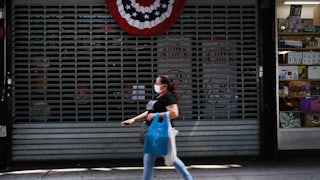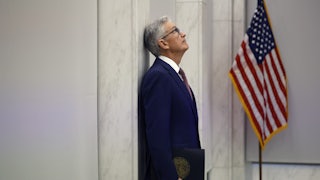Last week, the U.S. Centers for Disease Control and Prevention released the results of its testing of masks for preventing the spread of Covid-19: Any mask is better than none, and the tighter the fit, the better. With the spread of more contagious forms of the virus continuing, the CDC advised people to opt for high-quality masks like the N95, or double up on the cloth or disposable versions. Though the effectiveness of masks against Covid-19 is positive news in the middle of a crisis, the cost of following the CDC guidance on mask-wearing (and replacement) is just one more burden added to households already on the brink.
As our understanding of the virus has evolved, the government response to the issue has lagged behind the reality of the crisis; guidance on mask-wearing does not seem to take into account the tangled web of structural inequalities that millions of people in the United States must navigate. In the calculus of paying bills or buying groceries, setting aside a “mask fund” is often not in the cards. The people facing these lose-lose scenarios are also the most vulnerable to the virus, the working class and the working poor who cannot stay home and do their jobs remotely. In this public health crisis, people need a government response that empowers them to engage in best practices even at their most vulnerable. This means providing masks directly or giving people a stipend to purchase high-quality masks.
The cost of a box of disposable masks can go anywhere from $9 to over $30 at a local drugstore; online the variation is even wider: A pack of 20 KN95 masks (the best level of protection) is $40. Experts recommend washing reusable masks and replacing disposable masks after each use; for a family of five that can easily go through a box of masks a week, the cost adds up. For the increasing number of Americans facing food and housing insecurity, high-quality masks are simply not in the budget. So why has one of the richest nations in the world made it this far into the pandemic without some kind mass distribution system of free masks, or even a mask allowance?
The CDC issued a variety of mask recommendations but little else, leaving people to navigate a nightmare marketplace on their own and hope for the best. Some online sellers saw the pandemic as a lucrative business opportunity, hoarding and then selling hand sanitizer and masks for wildly inflated prices. Throughout the pandemic, reporting has revealed some of the masks in high demand were frauds, and though they were sometimes stamped with the logo of well-known manufacturers, these masks didn’t offer the same protection as the real thing. The fakes were so convincing, in fact, that several states and hospital systems purchased them as personal protective equipment for their frontline workers. Cassie Sauer, the president and chief executive of the Washington State Hospital Association, told The New York Times that the association’s hospitals had bought hundreds of thousands of the “really good fakes.”
While the federal and state response to the pandemic has been largely inadequate, we have seen certain programs expand to meet increased need. In the early months of the pandemic, the Families First Coronavirus Response Act enhanced the amount of SNAP benefits a family could receive and made it easier to qualify for the assistance; the federal expansion of food stamp eligibility shows that the government understands the need to support people with the necessities. (Still, nearly a year into the pandemic, scores of Americans are months behind on rent and have depleted their savings, and now rely on the generosity of local food banks to supplement their basic needs in this time of unprecedented job loss and economic uncertainty.)
Other countries have taken a different approach to supporting residents throughout the crisis, with some providing regular financial support to citizens and others taking a more hands-on approach to managing public health. In November, for example, the government of Spain dropped the sales tax on disposable masks from 21 percent to 4 percent, and capped the price at 0.62 euros. The country, previously with one of the highest numbers of infections in its region, saw a drop in cases soon afterward. In Portugal, a similar strategy was employed by several cities: Portimão delivered an envelope with six masks to every person, and Lisbon delivered masks to the vulnerable populations in isolation. The country went months without a rise in cases as other countries saw cases surge out of control.
The U.S. struggle with the rollout of vaccines is due in large part to creating an entirely new delivery system. Masks are an essential part of making the other approaches successful; keeping community transmission low gives the virus fewer opportunities to mutate and potentially become resistant to a vaccine. The system needed to deliver masks to the entire country is already in place: the U.S. Postal Service. In fact, in April 2020, only a few months into the pandemic and in the midst of the chaotic rush to buy masks, the USPS was preparing to announce it would be delivering five masks to every address it serviced, but the plan was nixed by the Trump administration. Though the previous administration may have missed an opportunity, the new administration can reverse course and support the USPS’s original proposal. In the midst of soaring case numbers and lagging vaccine rollouts, the federal government needs to leverage the framework already in place to provide masks to everyone, and more than just five masks at a time.
The supply of masks is also readily available as dozens of American companies modified and ramped up production to address the high demand. Yet, due to the limitations placed on selling online during the crackdown on price-gouging and fraud, and the reluctance of major hospital systems to go with a new brand, The New York Times reports that there are businesses with millions of dollars of masks in stock that they are not able to sell.
Some local governments decided not to wait for the federal government to shift into action and are already working to provide free masks to the most vulnerable. The Arizona Department of Health Services paired with Hanes to provide reusable cloth masks to anyone over 65 years old. Each order comes with five masks and is limited to one order per household. The state saw a drop in cases shortly after the rollout of the MaskUp program.
The Biden administration can demonstrate its understanding of the depths of this crisis and take bold action to serve the public. We have the supply, the demand, and the delivery system; now we need the federal government to step up to the plate.








